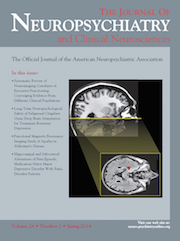Subjects and Study Design
In our retrospective study-design, patients were identified who were admitted to the University Hospital of Salzburg, Department of Neurology, from June 1, 2007 to June 30, 2011. An electronic database selected patients who were free of unrelated psychiatric and neurological disease and had undergone a cerebral Magnetic Resonance Imaging (MRI) procedure with a minimum number of images and a neuropsychological examination (N=321). MRI and neuropsychological testing were performed within 3 months. Reasons for referral were planned carotid artery stenting because of asymptomatic carotid artery disease and subjective cognitive impairment. Patients’ records and results of brain MRI images were rechecked again manually (by M.S.) and the following exclusion criteria were applied: presence of severe psychiatric disease (e.g., depression, schizophrenia spectrum disorders), presence of severe unrelated central nervous disease (e.g., transient ischemic attack, stroke, multiple sclerosis, Parkinson’s disease, epilepsy) and leukoencephalopathy of non-vascular origin (e.g., immunological-demyelinating, metabolic, toxic, infectious).
SIVD patients were identified according to the brain-imaging criteria proposed by Erkinjuntti
8 (N=58). The age- and gender-matched control group comprised 58 patients who did not meet the applied SIVD criteria.
Magnetic Resonance Imaging (MRI)
MRI was performed on a 3-Tesla, whole-body MRI scanner (Achieva; Philips, the Netherlands). Coronar T1-weighted images (36 slices, TR: 451 msec, TE: 13 msec, thickness: 4 mm/1, flip: 80, Turbo Factor: 1, matrix: 512, time: 2:31 minutes); axial T2 images (28 slices, TR: 3,048 msec, TE: 80 msec, thickness: 4 mm/1, Turbo factor: 15, EPI factor: 1, matrix: 512, time: 1:19 minutes); and fluid attention inversion recovery (FLAIR) axial sequences (28 slices, TR: 10,000 msec, TE: 125 msec, TI: 2,800 msec, thickness: 4 mm/1, Turbo factor: 32, EPI factor: 1, matrix: 560, time: 3:30 minutes) were required.
Medial temporal lobe atrophy was graded by two raters (M.S. and Y.K.), blinded to neuropsychological data, on a 5-point Likert-scale
17 considering the width of the choroid fissure, the width of the temporal horn, and the height of the hippocampal formation. Frontal lobe atrophy was rated by two raters (M.S. and Y.K.) blinded to neuropsychological data on a visual 4-point Likert scale (none, mild, moderate, severe) considering sulcal and ventricular sizes. In case of rater disagreement, mean scores of the two ratings were used for calculation.
Changes in cerebral white matter were rated by an experienced neurologist (M.S.) and an experienced neuroradiologist (M.M.), blinded to neuropsychological data, according to the revised version of the Fazekas scale
18 and classified as “none” (0; no white-matter lesions), “mild” (1; single lesions <10 mm and grouped lesions <20 mm in any diameter), “moderate” (2; single lesions 10 mm–20 mm, grouped lesions >20 mm with connecting bridges only between the individual lesions), or “severe” (3; confluent lesions with >20 mm in any diameter). In case of rater disagreement, consensus was reached in a second rating session.
MRI-defined SIVD was diagnosed according to the brain-imaging criteria proposed by Erkinjuntti,
8 which include 1) cases with predominantly white-matter lesions (WML), that is, extending periventricular and deep white-matter lesions (extending caps or irregular halo and diffusely confluent hyperintensities or extensive white-matter changes) and lacunas (at least 1); and 2) cases with predominantly lacunar infarcts, that is, >5 lacunas and at least moderate WML (extending caps or irregular halo or diffusely confluent hyperintensities or extensive white-matter changes). We also required absence of cortical and/or cortico–subcortical non-lacunar territorial infarcts, watershed infarcts, hemorrhages, signs of normal-pressure hydrocephalus, and specific causes of WML of non-vascular origin (e.g., multiple sclerosis, sarcoidosis, residual lesions of vasculitis).
In case of rater disagreement, consensus was reached in a second rating session.
Neuropsychological Examination
Each patient completed the Mini-Mental State Exam,
19 and the neuropsychological test battery established by the Consortium to Establish a Registry for Alzheimer's Disease (CERAD-Plus).
20,21 The CERAD is composed of several subtests: Semantic Verbal Fluency (SVF), Phonemic Verbal Fluency (PVF), Boston Naming Test (BNT), Word-List Learning (WLL), Word-List Delayed Recall (WLDR), Word-List Recognition (WLR), Discriminability (D), Figure Copy (FC), Figure Recall (FR), and Trail-Making Tests–A and B (TMT-A, B).
The test battery assesses verbal fluency (SVF, PVF), constructional praxis (FC), figurative memory (FR), verbal short-term and long-term memory (WLL, WLDR, WLR), verbal recognition memory (D), semantic processing (BNT), speed of cognitive processing (TMT A), and divided attention (TMT B).
All given values are z-scores adjusted for level of education, age, and gender.
Statistical Analysis
SPSS Student Version 16.0 was used for computation. A p level <0.05 was considered to be statistically significant.
When comparing individuals with SIVD versus the non-SIVD reference group, the Mann-Whitney U test or chi-squared test were used as appropriate.
To delineate the association of white-matter lesion load with cognitive test scores, univariate analysis was used. Interobserver reliability is expressed by complete agreement in percent and kappa values.

